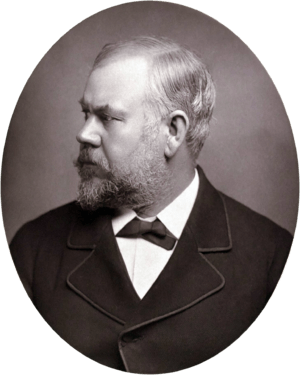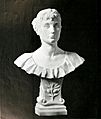Henry Hugh Armstead facts for kids
Quick facts for kids
Henry Hugh Armstead
|
|
|---|---|

Armstead in 1879
|
|
| Born | 18 June 1828 Bloomsbury, London, England
|
| Died | 4 December 1905 (aged 77) St John's Wood, London, England
|
| Resting place | Highgate Cemetery |
| Known for | sculptor and illustrator |
| Elected | Royal Academy |
Henry Hugh Armstead RA (born June 18, 1828, died December 4, 1905) was a famous English sculptor and illustrator. He was inspired by a group of artists called the Pre-Raphaelites.
Contents
Henry Hugh Armstead's Life and Art
Henry Hugh Armstead was born in Bloomsbury, central London. His father, John Armstead, was a skilled craftsman. He worked with metal and engravings. Henry learned a lot from his father first. Later, he studied art at the Government School of Design and other private art schools. He also learned from another artist named Edward Hodges Baily.
When he was eighteen, Armstead started working for silversmiths named Hunt and Roskell. He created many beautiful silver pieces there. These included the Kean Testimonial, a set of nine silver items. They were given to the actor Charles Kean. He also made the Outram Shield in 1862. This shield was presented to Lieutenant-General Sir James Outram. Armstead would first make clay models. Then he would chase, or decorate, the cast silver.
In the late 1850s, Armstead was asked to create a statue of Aristotle. This statue, made of Caen stone, was for the Oxford University Museum of Natural History. After this project, he started focusing more on sculpture. He designed special carvings called friezes for the outside of Eatington Hall. These were part of a big renovation project between 1858 and 1862. Other artists carved them based on his designs.
Famous Works and Public Art
Armstead's work at the Palace of Westminster and the Albert Memorial helped him become very well-known. He then created many public statues. He also made sculptures for tombs and other buildings.
At the Palace of Westminster, Armstead carved eighteen oak panels. These panels were in the Queen's Robing Room. They showed scenes from the legend of King Arthur. These carvings were placed below paintings by William Dyce.
Armstead worked closely with architect George Gilbert Scott on the Albert Memorial. He made small models of the sculptures for Scott's design. For the actual monument, Armstead created half of the Frieze of Parnassus. This frieze shows 169 important cultural figures. It was carved from hard Canpanella marble. Armstead carved the poets, musicians, and artists on the south side. He also carved the painters on the east side. Another sculptor, John Birnie Philip, carved the other two sides.
Armstead was very careful with details. He even asked friends of famous people like Goethe and Beethoven for advice. He also used Carl Maria von Weber's death-mask to help with accuracy. The sculptures were carved right on the monument. They were not made in his studio. The relief was finished in 1872. Armstead also made some of the bronze statues. These statues represented different sciences. They were placed on the upper levels of the memorial.
Armstead also worked with John Birnie Philip on the outside sculptures of Scott's Colonial Office in Whitehall. Armstead also sculpted a large fountain at King's College, Cambridge. This fountain was made between 1874 and 1879. It included a statue of the college's founder, Henry IV. He also created many statues for tombs. These included statues of Bishop Wilberforce at Winchester and Lord John Thynne at Westminster Abbey.
Later Life and Legacy
Armstead became an Associate of the Royal Academy in 1875. He became a full member in 1880. In 1884, he was chosen to sculpt a monument. This monument was for Archibald Campbell Tait, the late Archbishop of Canterbury. It is located in the south transept of Westminster Abbey.
Henry Hugh Armstead lived in different parts of London. He died at his home in St John's Wood on December 4, 1905. He is buried in a family grave at Highgate Cemetery. One of his works is also nearby in the west Cemetery. It is in the Julius Beer Mausoleum. This sculpture shows Ada Beer, Julius's young daughter, in the arms of an angel.
Images for kids
-
Armstead's 1879 fountain in the Front Court of King's College, Cambridge
-
Holy Trinity, Sloane Street, bronze lectern
-
Interior of Exeter Guildhall: bust of Queen Victoria
See also
 In Spanish: Henry Hugh Armstead para niños
In Spanish: Henry Hugh Armstead para niños








